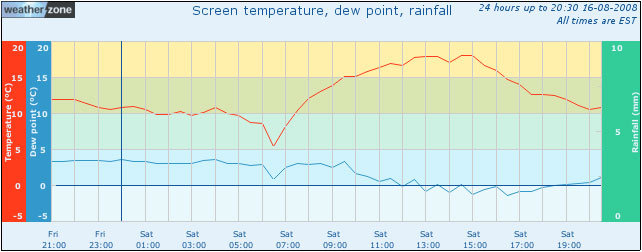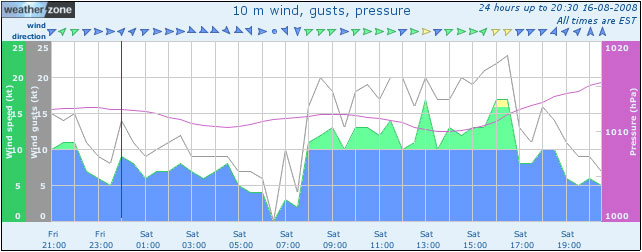Flying Training
Lesson 64: Solo in Warrior
Sunday 16 Aug 2008, 4.00pm in Warrior VH-LJL
Weather: wind WSW, 17 knots, gusting to 23 (died down later).
On arrival at Camden the conditions looked a little challenging with some strong gusts and and changes of direction. However it didn't seem to be stopping anyone else, and it was mainly headwind rather than crosswind, so I went ahead. Actually I was kept waiting by the slight absence of an aeroplane (due to someone arriving late earlier in the day), and by the time I landed the wind had dropped substantially, as you can see by the graph below.



 While I waited for LJL to arrive back, I was lucky enough to see Tim take the T-6 Texan up for
a few circuits, with his younger brother Michael in the back. Tim's now 18 - his first solo was at
16 in a Tiger Moth so from my point of view he's a bit of a prodigy. Most parents are concerned
about their 18 year old taking the Commodore for a spin, and here's Tim flying a vintage aircraft
with somewhere over 1000 hp up front. Before the last landing he made a flypast
of the airfield - the sound of the big radial engine was tremendous.
While I waited for LJL to arrive back, I was lucky enough to see Tim take the T-6 Texan up for
a few circuits, with his younger brother Michael in the back. Tim's now 18 - his first solo was at
16 in a Tiger Moth so from my point of view he's a bit of a prodigy. Most parents are concerned
about their 18 year old taking the Commodore for a spin, and here's Tim flying a vintage aircraft
with somewhere over 1000 hp up front. Before the last landing he made a flypast
of the airfield - the sound of the big radial engine was tremendous.


 Eventually LJL showed up and off I went. Run-up facing into wind, then a 180°
turn to the taxiway. Held for traffic, then was told to line up. After the aircraft
just landed had cleared the runway I was off, climbing quickly to 800 feet. It was pretty
bumpy and I recall thinking that a passenger such as Alexander wouldn't enjoy this much.
I levelled off at 1300 feet and set course for The Oaks, climbing to 4000 feet once clear of the
CTA. As I'd hoped, it was smoother at this altitude, and there was a good view over the
tiger country to the west.
Eventually LJL showed up and off I went. Run-up facing into wind, then a 180°
turn to the taxiway. Held for traffic, then was told to line up. After the aircraft
just landed had cleared the runway I was off, climbing quickly to 800 feet. It was pretty
bumpy and I recall thinking that a passenger such as Alexander wouldn't enjoy this much.
I levelled off at 1300 feet and set course for The Oaks, climbing to 4000 feet once clear of the
CTA. As I'd hoped, it was smoother at this altitude, and there was a good view over the
tiger country to the west.
Following the example set in the last flight with Jim Drinnan, I picked a clear area, carried out the HASELL checks and practiced a few stalls, turning 90° between each one. As before, it wouldn't actually stall, just descended at 500 feet per minute.
I simulated a forced landing (remaining above 1500 feet) and then did the usual rounds of the training area, noticing at one point an aircraft well below me doing a PFL.
 I switched to the
ATIS.
just after 5pm to find the tower was closed and
CTAF
was in force. Although the sun was now behind a bank of clouds to the west and
it was getting dark there were still several aircraft in the circuit and I
decided to join them. A quick flick through the Sydney Visual Flight Guide to
conform that the procedure (when the runway in use is known) is to descend to
circuit height and join the downwind leg at 45°.
I switched to the
ATIS.
just after 5pm to find the tower was closed and
CTAF
was in force. Although the sun was now behind a bank of clouds to the west and
it was getting dark there were still several aircraft in the circuit and I
decided to join them. A quick flick through the Sydney Visual Flight Guide to
conform that the procedure (when the runway in use is known) is to descend to
circuit height and join the downwind leg at 45°.
The runway lights were already on, but I had time for three circuits and was actually the last aircraft to land for the day. A photo of the runway lights would have been a novelty but I was concentrating on a stable approach, a flare at the right point and a proper hold-off.
Next flight is either another passenger flight, perhaps with Angus, or the long-delayed nav to Bathurst and Orange.
Weather


